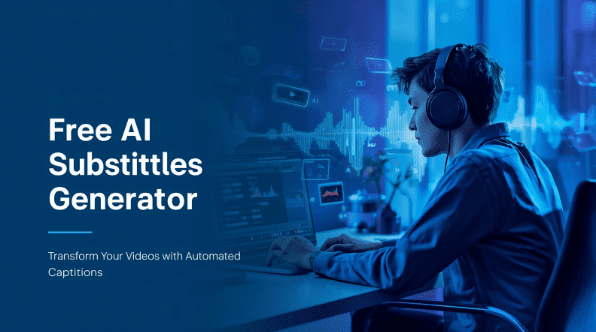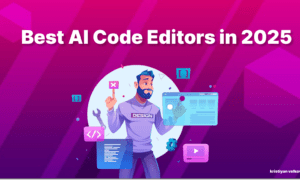Videos rule the feed—44 % of marketers already let AI do the editing. What makes people actually watch? Subtitles. The AI video market is set to hit $2.56 billion by 2032, climbing 19.5 % each year. Behind the boom are AI subtitle tools that give creators their time back and make every clip easier to follow and share.
The Top 4 Free AI Subtitle Generators in 2025 (Get Accurate Captions Fast)
WayinVideo: The All-in-One Video Repurposing Powerhouse
WayinVideo stands out as a comprehensive AI video repurposing and subtitle generation tool that’s changing how creators work with video content. What makes it particularly impressive is its ability to not just generate subtitles but to identify key moments and transform long-form content into engaging, shareable clips. The platform supports multiple input sources including local files (MP4, MOV) and direct links from YouTube and 12+ other platforms like TikTok, Facebook, and Vimeo.
The free tier of WayinVideo offers daily free credits so users can experience its powerful AI video tools firsthand. Once the credits are used up, additional usage is available through a subscription plan. Its true strength lies in features like “One Click Viral Clips” and AI-driven video search. Users can find specific moments across platforms such as YouTube, Vimeo, TikTok, Facebook, or Dailymotion, as well as from local video files, simply by using natural language prompts. Imagine asking, “Find all moments where Elon Musk talks about Mars,” and instantly receiving precise, ready-to-share clips — that’s the power of WayinVideo.
Best for: Content creators who need to repurpose long videos into social media-ready clips, podcasters looking to create highlight reels, and marketing teams focused on extracting maximum value from their video assets.
Invideo AI: The Creative’s Choice for Automated Video Production
Invideo AI positions itself as more than just a subtitle generator – it’s a complete video creation platform. While specific details about its free tier limits aren’t available, the tool has gained recognition for its ability to transform text prompts into fully-produced videos, complete with subtitles. The platform’s AI capabilities extend beyond simple transcription, helping users create engaging content with minimal manual intervention.
What sets Invideo AI apart is its focus on the creative aspects of video production. The tool doesn’t just add captions; it helps creators produce polished videos that stand out on social media platforms. For those who want to combine subtitle generation with broader video creation capabilities, Invideo AI offers a compelling solution.
Best for: Social media managers, digital marketers, and creators who want to generate complete video projects from text prompts while ensuring accurate subtitles are included automatically.
VEED.IO: The Comprehensive Online Editor
VEED.IO offers a middle ground between CapCut’s simplicity and professional editing software’s complexity. As an online video editor, it requires no installation and works directly in your web browser, making it accessible across all devices. Its intuitive UI and automatic subtitle features make it ideal for social media content creation.
While VEED.IO doesn’t specialize exclusively in short-form content like SendShort, it provides a more comprehensive editing experience. You can add automatic subtitles, trim videos, apply effects, and customize your output extensively. For creators who want more control than SendShort offers but don’t want the complexity of desktop software, VEED.IO strikes the perfect balance.
Kapwing: The No-Fuss Alternative
Kapwing rounds out our top CapCut alternatives with its focus on simplicity and efficiency. Like VEED.IO, it’s a web-based editor that requires no installation, making it accessible to creators with varying technical skills. The platform is particularly popular among educators and content creators who need straightforward video editing without unnecessary complexity.
While Kapwing may not offer the same level of automation as SendShort or the comprehensive features of VEED.IO, its strength lies in its no-fuss approach. For creators who found CapCut’s mobile limitations frustrating but don’t need advanced features, Kapwing provides reliable subtitle generation and basic editing capabilities in a clean, intuitive interface.
How to Automatically Generate Subtitles with AI: A Step-by-Step Guide
Step 1: Choosing and Uploading Your Video
The journey to perfectly captioned content begins with selecting the right video and uploading it to your chosen AI platform. With WayinVideo, for instance, you have multiple options: upload local files directly from your computer (supporting formats like MP4 and MOV) or simply paste a URL from YouTube or other supported platforms. The platform’s versatility extends to supporting over 12 different platforms, including TikTok, Facebook, and Vimeo, making it incredibly convenient for creators working across multiple channels.
When preparing your video for upload, consider the audio quality first. Clear audio with minimal background noise will yield significantly better transcription results. The AI engines powering these subtitle generators work best with distinct speech, so if you’re recording original content, invest in a good microphone and record in a quiet environment. This small upfront effort will save you considerable time in the editing phase later.
Step 2: Initiating AI Subtitle Generation
Once your video is uploaded, locating the subtitle generation feature is typically straightforward. In WayinVideo’s interface, you’ll find a prominent button labeled “Generate Captions” within the video editing dashboard.
The beauty of modern AI subtitle generators lies in their simplicity – a single click is often all it takes to begin the transcription process. The platform will immediately start analyzing your video’s audio track, using advanced speech recognition algorithms to convert spoken words into text. This process typically completes within minutes, even for longer videos, thanks to the efficiency of cloud-based AI processing.
Step 3: Language Selection and AI Transcription
After initiating the process, you’ll need to select the language spoken in your video. WayinVideo supports multiple languages, though the exact number isn’t specified in the current data. This multilingual capability is crucial for creators working with international content or targeting diverse audiences. Simply choose the appropriate language from the dropdown menu, and the AI will adjust its recognition models accordingly.
The AI transcription phase is where the magic happens. The system processes your video frame by frame, synchronizing the generated text with the audio timeline. Modern AI subtitle generators can distinguish between different speakers, identify punctuation, and even recognize context to improve accuracy. For best results, ensure you’ve selected the correct language variant (e.g., US English vs. UK English) as this can significantly impact transcription quality.
Step 4: Reviewing and Editing for Accuracy
Even the most advanced AI subtitle generators aren’t perfect, which is why the review and editing phase is crucial. WayinVideo provides an intuitive editor where you can review the transcribed text word by word. The platform allows you to correct transcription errors, adjust timestamps for perfect synchronization, and even assign speaker labels to distinguish between multiple participants.
The editing interface typically displays your video alongside the transcript, allowing you to click on any word to jump to that moment in the video. This makes it easy to verify accuracy and make corrections efficiently. Pay special attention to technical terms, names, and industry-specific jargon, as these are most likely to be misinterpreted by the AI. Taking 10-15 minutes to review and edit your subtitles can transform them from 90% accuracy to near-perfect quality.
Step 5: Customizing Subtitle Style
Once your subtitles are accurate, it’s time to make them visually appealing. WayinVideo offers extensive customization options including fonts, colors, sizes, positions, and even animation effects. These styling options aren’t just about aesthetics – they play a crucial role in viewer retention, especially for content consumed without sound.
Consider your brand guidelines when customizing subtitles. Choose fonts that align with your visual identity, select colors that provide adequate contrast against your video backgrounds, and adjust sizing for readability across different devices. Animated captions can add dynamism to your content, particularly for social media platforms where engagement is key. Remember, the goal is to make your subtitles enhance rather than distract from your content.
Step 6: Exporting Your Final Product
The final step is exporting your content with the newly generated subtitles. WayinVideo offers two primary export options: downloading a separate .SRT file or exporting the video with burned-in captions. The .SRT option is ideal for platforms like YouTube that support external subtitle files, allowing viewers to toggle captions on or off. Burned-in captions, however, ensure your subtitles are visible on all platforms, making them perfect for social media where auto-play often occurs with sound off.
Additionally, WayinVideo allows you to adjust the aspect ratio before exporting, transforming your video into formats optimized for different platforms. Convert your horizontal video into a 9:16 vertical format for Instagram Reels or TikTok, or a 1:1 square format for Instagram feed posts. This repurposing capability, combined with accurate subtitles, maximizes the reach of your content across multiple channels.
Can AI Generate More Than Just Subtitles? A Look at AI Video Generators
AI video generators have evolved far beyond simple subtitle addition, transforming into comprehensive content creation platforms. Tools like Invideo AI and Visla now offer capabilities that were unimaginable just a few years ago – generating complete videos from text prompts, selecting appropriate stock footage, adding background music, and creating voiceovers automatically.
The underlying technology has matured significantly, with AI models now capable of understanding context, matching visual elements to narrative themes, and even generating custom imagery. This progression represents a fundamental shift in video production, democratizing access to professional-quality content creation for those without technical skills or extensive resources.
How Accurate Are AI Subtitles & How to Fix Them?
Setting Realistic Expectations for AI Accuracy
AI subtitle generators have made remarkable progress in accuracy, but it’s important to set realistic expectations. The industry standard for high-quality audio typically ranges between 90-98% accuracy, with variables like audio quality, background noise, number of speakers, accents, and technical terminology all playing crucial roles in the final result.
The reference data shows Steve AI claiming 95% accuracy, which serves as a good benchmark for what to expect from premium services under optimal conditions. However, real-world conditions often fall short of these ideals, with factors like poor audio quality, multiple speakers talking over each other, or specialized vocabulary potentially reducing accuracy rates significantly.
Factors Impacting Transcription Accuracy
Audio Quality: The single most important factor is the quality of your source audio. Clear, well-recorded speech with minimal background noise will yield the best results. Use a quality microphone, record in a quiet environment, and consider using noise reduction tools if necessary before uploading your video.
Speaker Characteristics: Accents, speech patterns, and vocal clarity all impact AI transcription. Some AI models perform better with certain accents or speech patterns than others. If your content features speakers with strong accents or unusual speech patterns, you may need to budget more time for editing.
Content Complexity: Technical jargon, industry-specific terminology, and proper names often challenge AI transcription systems. While some platforms allow you to add custom vocabulary or terminology lists, many struggle with specialized content without additional training or customization.
Multiple Speakers: Conversations with multiple participants, especially when they talk over each other, present significant challenges for AI transcription. Some advanced systems can distinguish between different speakers, but accuracy typically decreases with each additional voice.
Efficient Editing Workflows
Despite these challenges, there are strategies to efficiently edit AI-generated subtitles:
The First Pass Review: Start by watching your video with the AI-generated subtitles enabled, focusing on catching obvious errors rather than perfecting every detail. This quick review helps identify major issues that might require re-transcription or significant editing.
Focused Correction Sessions: Rather than trying to fix everything at once, focus on specific types of errors in separate passes. For example, one pass for technical terms, another for punctuation, and a third for timing adjustments. This systematic approach is more efficient than trying to address everything simultaneously.
Leverage Speaker Labels: If your platform supports speaker identification (like WayinVideo), use these features to organize your editing process. Focus on one speaker at a time, as you’ll become more familiar with their speech patterns and common error types.
Timing Adjustments: Often, the text itself is accurate but the timing is slightly off. Rather than re-typing entire sections, focus on adjusting timestamps to sync subtitles perfectly with the audio. Most platforms make this easy with drag-and-drop timeline interfaces.
From a Creator’s Perspective: Do AI-Generated Subtitles Feel “Lazy” or Unprofessional to Viewers?
Understanding Viewer Perceptions
The question of whether AI-generated subtitles appear lazy or unprofessional is a common concern among creators, and the answer is nuanced. Based on extensive community discussions from platforms like Reddit’s r/NewTubers, r/PartneredYoutube, and r/socialmedia, viewer perceptions depend less on the method of generation and more on the quality of the final product.
As one Reddit user from r/PartneredYoutube expressed, “As long as I can read it and understand it, I don’t really care if it was AI or a person. Accuracy is key.” This sentiment is echoed across multiple communities, where viewers prioritize functionality and accuracy over the method of creation.
The Critical Distinction: Edited vs. Unedited AI Captions
The crucial factor in viewer perception seems to be whether AI-generated captions have been properly edited and reviewed. Unedited, error-filled AI captions are frequently criticized as unprofessional and indicative of creator laziness. As one viewer noted on Reddit, “Honestly, I can’t stand watching videos with those broken auto captions. Makes it feel like the creator didn’t care.”
However, when creators take the time to review and edit AI-generated captions, viewer perceptions shift dramatically. Well-edited captions, even if AI-assisted, are generally accepted and appreciated for improving accessibility. The consensus across social media platforms is that the effort invested in ensuring accuracy and readability is what matters, not the initial method of generation.
Best Practices for Professional AI-Generated Subtitles
To ensure your AI-generated subtitles maintain a professional standard:
Thorough Editing: Always review and edit AI-generated captions for accuracy, punctuation, and timing. This extra step transforms potentially unprofessional output into polished, professional content.
Consistent Styling: Use your platform’s customization features to maintain consistent subtitle styling that aligns with your brand. Professional appearance matters as much as accuracy in viewer perceptions.
Contextual Accuracy: Pay special attention to technical terms, names, and context-specific language that AI might misinterpret. These errors are particularly noticeable to viewers familiar with your content’s subject matter.
Timing Precision: Ensure subtitles sync perfectly with the audio. Out-of-sync captions are jarring and immediately perceived as unprofessional, regardless of their accuracy.
FAQ Section
How do AI subtitle generators handle multiple speakers?
AI subtitle generators use speaker diarization algorithms to distinguish and tag different voices based on pitch, cadence, and frequency. However, accuracy can drop when multiple people talk at the same time or when their voices sound similar.
Most tools still offer only basic transcription features and lack reliable speaker identification. That’s why we recommend using WayinVideo, which includes AI-powered speaker labeling. It automatically tags each speaker, making it especially useful for meetings, podcasts, and other multi-speaker scenarios where accurate subtitles and transcripts matter.
Conclusion
AI subtitle generators are transforming the way creators connect with global audiences—making videos more accessible, engaging, and shareable than ever before. In 2025, tools like WayinVideo, Invideo AI, VEED.IO, and Kapwing empower creators to produce polished, captioned content effortlessly, without sacrificing quality or creativity.
By combining the speed and intelligence of AI with thoughtful customization, you can ensure your subtitles enhance your message and align with your brand. Far from replacing human touch, AI amplifies it—freeing you to focus on storytelling while handling the technical heavy lifting.
Embrace these tools, refine your workflow, and unlock the full potential of every video. With AI-powered subtitles, your content doesn’t just reach more people—it resonates more deeply.



































